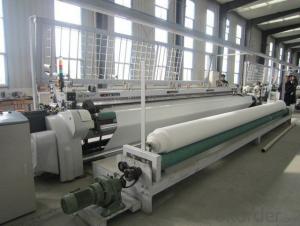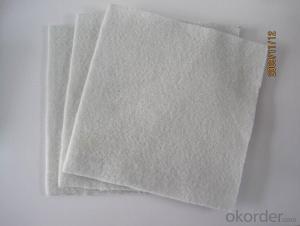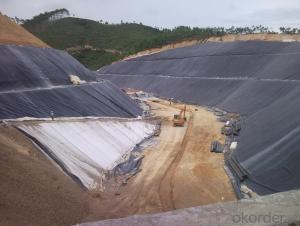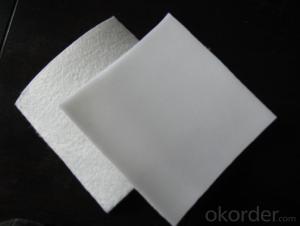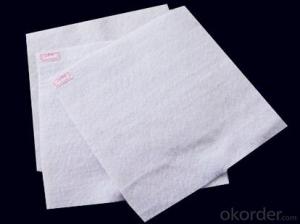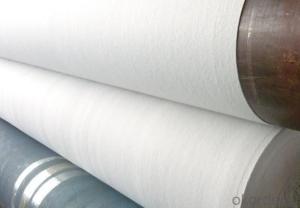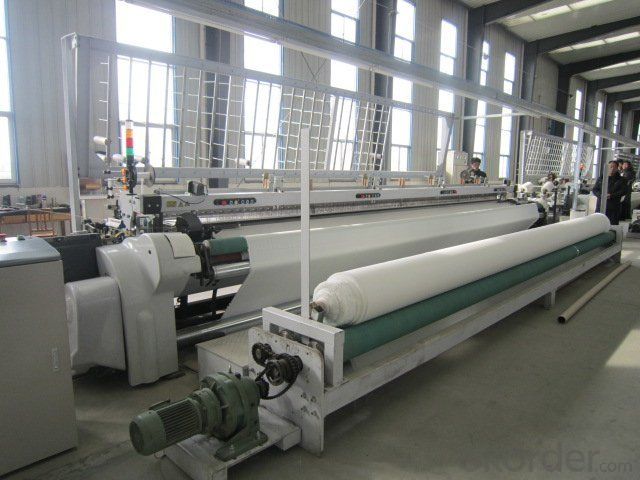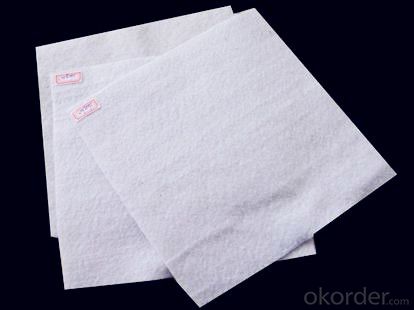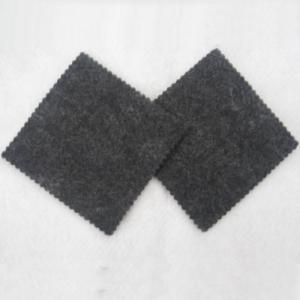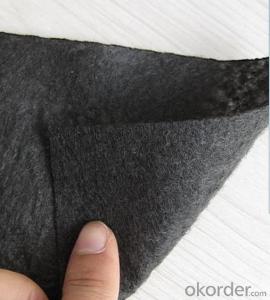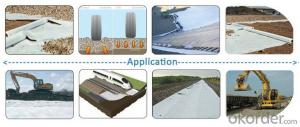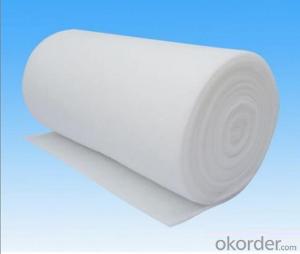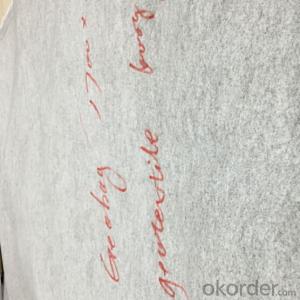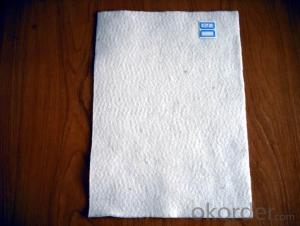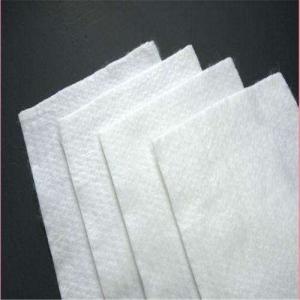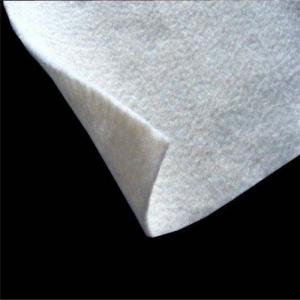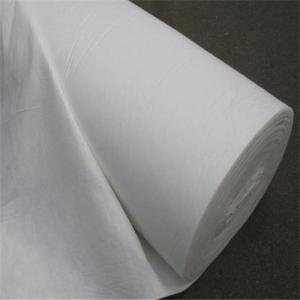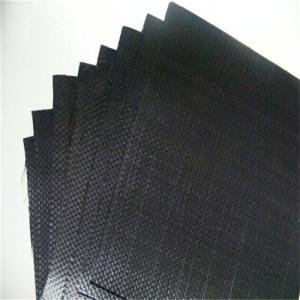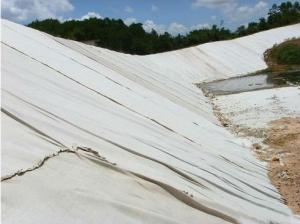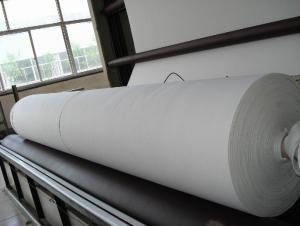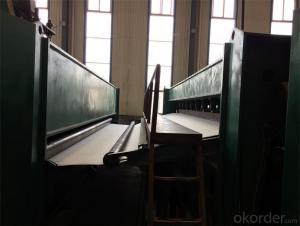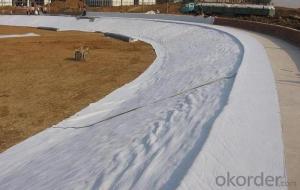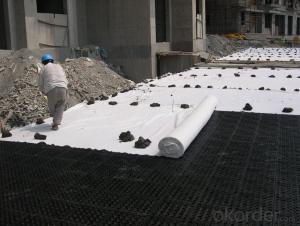Tarif Composite Nonwoven Geotextile for Road Construction
- Loading Port:
- Qingdao
- Payment Terms:
- TT OR LC
- Min Order Qty:
- 10000 m²
- Supply Capability:
- 500000 m²/month
OKorder Service Pledge
OKorder Financial Service
You Might Also Like
Composite Nonwoven Geotextile Images
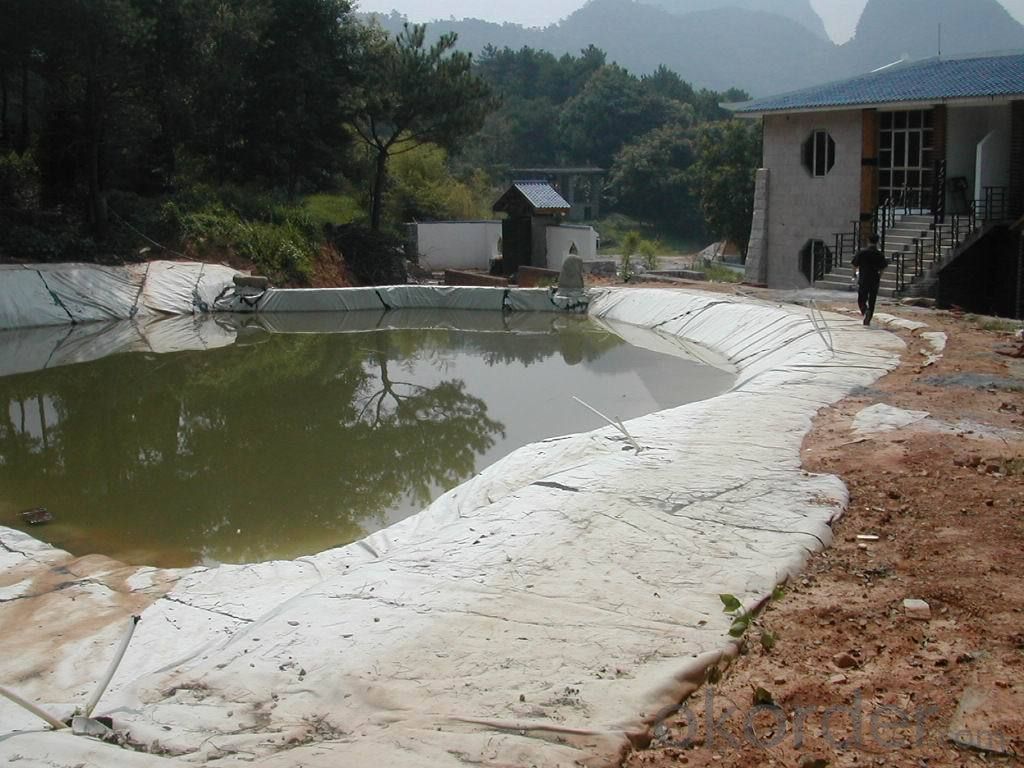
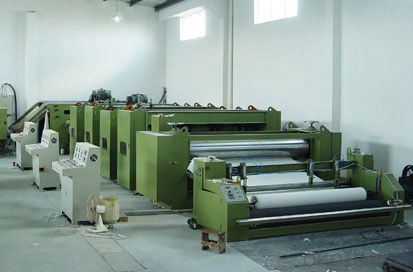
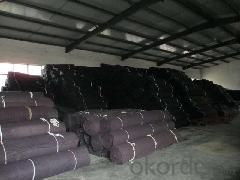
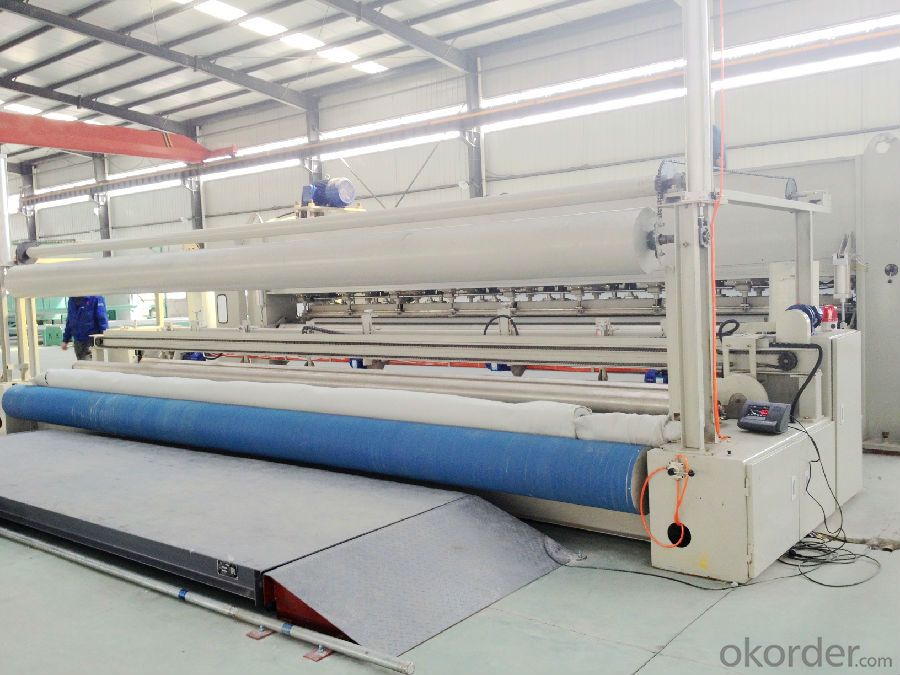
Composite Nonwoven Geotextile Specification:
| Properties | Unit | PET100 | PET150 | PET200 | PET250 | PET300 | PET350 | PET400 | PET450 | PET500 | PET600 | PET800 | |
| Mechanical Properties | |||||||||||||
| Tensile Strength | MD | KN/m | 2.5 | 4.5 | 6.5 | 8.0 | 9.5 | 11.0 | 12.5 | 14.0 | 16.0 | 19.0 | 25.0 |
| TD | KN/m | 2.5 | 4.5 | 6.5 | 8.0 | 9.5 | 11.0 | 12.5 | 14.0 | 16.0 | 19.0 | 25.0 | |
| Tear Strength | MD | KN≥ | 0.08 | 0.12 | 0.16 | 0.20 | 0.24 | 0.28 | 0.33 | 0.38 | 0.42 | 0.46 | 0.60 |
| TD | KN≥ | 0.08 | 0.12 | 0.16 | 0.20 | 0.24 | 0.28 | 0.33 | 0.38 | 0.42 | 0.46 | 0.60 | |
| CBR Plunger Strength | KN≥ | 0.3 | 0.6 | 0.9 | 1.2 | 1.5 | 1.8 | 2.1 | 2.4 | 2.7 | 3.2 | 4.0 | |
| Elongation at Yield | MD | % | 25~100 | ||||||||||
| TD | % | 25~100 | |||||||||||
| Hole Size | O90(O95) | mm | 0.07~0.2 | ||||||||||
| Vertical Permeability | cm/s | k*(10-1~10-3),k=1.0~9.9 | |||||||||||
| Identification Properties | |||||||||||||
| Material | / | Polyester | |||||||||||
| Color | / | White | |||||||||||
| Thickness | mm, ≥ | 0.9 | 1.3 | 1.7 | 2.1 | 2.4 | 2.7 | 3.0 | 3.3 | 3.6 | 4.1 | 5.0 | |
| Weight unit area | g/m² | 100 | 150 | 200 | 250 | 300 | 350 | 400 | 450 | 500 | 600 | 800 | |
| Forms of Supply | |||||||||||||
| Roll width | m | 1~6 | |||||||||||
| Roll length | m | 100 | |||||||||||
FAQ
We have organized several common questions for our clients,may help you sincerely:
Q1: How about your company?
A1:Our company are one of the largest geosynthetic products supplier in the world.We have the products experience more than 20 years.Already export to USA/Germeny/Australia/Zambia/Brazil etc.more than 20 countries.Almost 10years.Our products including Geocell/Fiberglass Geogrid/Geomembrane/Geotextile/Geonet etc.
Q2:Can you send samples to us ?
A2:Yes , free samples could be provided , but customer need pay for the freight cost .
After order placed , the freight charge could be refund .
Q3:What’s your Payment term ?
A3:T/T , L/C , Western Union,Paypal ...
Q4:What’s your manufacture process time ?
A4:Usually within 20 days
- Q: How do geotextiles help in preventing the loss of aggregate in parking lots?
- Geotextiles help in preventing the loss of aggregate in parking lots by acting as a barrier between the aggregate and the underlying soil. They provide stability and reinforcement to the parking lot surface, preventing the aggregate from being displaced or washed away due to traffic, erosion, or weather conditions. The geotextiles also help in distributing the load evenly across the surface, reducing the pressure on the aggregate and minimizing its movement. Overall, geotextiles play a crucial role in maintaining the integrity and longevity of parking lots by preventing the loss of aggregate.
- Q: What are the different functions of geotextiles in geoenvironmental engineering?
- Geotextiles serve various functions in geoenvironmental engineering, including erosion control, soil stabilization, drainage, filtration, and reinforcement. These materials prevent soil erosion by acting as a barrier against water flow and wind forces. They also stabilize soil by improving its mechanical properties, preventing soil movement and settlement. Geotextiles facilitate drainage by allowing water to pass through while retaining soil particles. They serve as a filtration layer, separating different soil layers and preventing the migration of fine particles. Additionally, geotextiles are used for reinforcement purposes, enhancing the strength and load-bearing capacity of soil structures.
- Q: How do geotextiles contribute to the sustainability of construction projects?
- Geotextiles contribute to the sustainability of construction projects in several ways. Firstly, they can act as a barrier to prevent soil erosion, which helps to protect the surrounding environment and maintain the integrity of the construction site. Secondly, geotextiles can enhance the stability and longevity of structures by providing reinforcement and improving soil mechanics. This reduces the need for excessive use of materials and resources, making construction projects more sustainable. Additionally, geotextiles can aid in the conservation of water resources by promoting proper drainage and preventing waterlogging. Overall, the use of geotextiles in construction projects helps to minimize environmental impacts while improving the efficiency and durability of structures, contributing to long-term sustainability.
- Q: Can geotextiles be used in underground applications?
- Yes, geotextiles can be used in underground applications. They are commonly used to separate, filter, and reinforce soils in various underground projects, such as drainage systems, roadways, retaining walls, and tunnels. Geotextiles help to improve soil stability, prevent soil erosion, and provide effective drainage, making them a valuable component in underground construction.
- Q: Are geotextiles resistant to rodent penetration?
- Yes, geotextiles are generally resistant to rodent penetration. They are designed to have a dense structure and strong construction that discourages rodents from burrowing or chewing through them. However, it is important to note that while geotextiles offer resistance, they may not be completely impervious to all types of rodents.
- Q: How are geotextiles made?
- Geotextiles are made by weaving or knitting synthetic fibers together to form a fabric that is durable, permeable, and resistant to various environmental conditions. These fibers are typically made of materials such as polyester or polypropylene, which undergo a manufacturing process that includes extrusion, spinning, and heat treatment. The resulting fabric is then often coated or laminated to enhance its performance and functionality in various applications, such as soil stabilization, erosion control, and drainage systems.
- Q: Geotextile types and role of geotextiles which types, respectively, what role, filament geotextile, short geotextile, composite geotextile, respectively, what role? More
- 1, acupuncture non-woven geotextile, specifications 100g / m2-1000g / m2 between any choice, the main raw material is the use of polyester staple fiber or polypropylene staple fiber, made by acupuncture, the main purposes are: river, sea, lake Embankment slope protection, reclamation, wharf, ship lock flood control and other projects, is through the filter to play a soil and water conservation and effective way to prevent piping. Second, acupuncture non-woven fabrics and PE film composite geotextile, specifications have a cloth a film, two cloth a film, the largest width of 4.2 meters The main raw material is to use polyester staple fiber acupuncture non-woven, PE film through the composite , The main purpose is anti-seepage, apply to railways, highways, tunnels, subways, airports and other projects. Third, non-woven and woven composite geotextile, a variety of non-woven and polypropylene filament woven composite, non-woven and plastic woven composite, for the basis of reinforcement, adjust the permeability coefficient of the basic engineering facilities. Features: light weight, low cost, corrosion resistance, with a filter, drainage, isolation, enhance the excellent performance. Use: widely used in water conservancy, electricity, mines, roads and railways and other geotechnical projects: l, soil separation of the filter material; 2, reservoirs, mine mineral processing of drainage materials, high-rise building drainage materials; Of the anti-erosion material; geotextile features 1, high strength, due to the use of plastic fibers, in dry and wet state can maintain sufficient strength and elongation. 2, corrosion-resistant, in different pH of the soil and water can be long-term corrosion resistance. 3, good water permeability between the fiber gap, it has a good water permeability. 4, good microbial resistance to micro-organisms, insects are not damaged. 5, construction convenience
- Q: What are the standards and specifications for geotextiles?
- The standards and specifications for geotextiles vary depending on the specific application and use of the geotextile. However, some common standards and specifications include physical properties such as tensile strength, elongation, puncture resistance, and filtration properties. Additionally, standards may also address factors like UV resistance, chemical compatibility, and installation guidelines. These standards ensure that geotextiles meet the desired performance requirements and are suitable for their intended use in various geotechnical and civil engineering applications.
- Q: How do geotextiles improve drainage systems?
- Geotextiles improve drainage systems by acting as a filter and separator, preventing the clogging of soil particles and allowing water to flow freely through them. This helps in preventing soil erosion, maintaining the stability of the soil, and enhancing the overall effectiveness of the drainage system.
- Q: Can geotextiles be used in underground drainage systems?
- Yes, geotextiles can be used in underground drainage systems. Geotextiles are often used as a filter and separator in these systems to prevent the migration of fine particles and to enhance the overall performance and longevity of the drainage system.
Send your message to us
Tarif Composite Nonwoven Geotextile for Road Construction
- Loading Port:
- Qingdao
- Payment Terms:
- TT OR LC
- Min Order Qty:
- 10000 m²
- Supply Capability:
- 500000 m²/month
OKorder Service Pledge
OKorder Financial Service
Similar products
Hot products
Hot Searches
Related keywords
